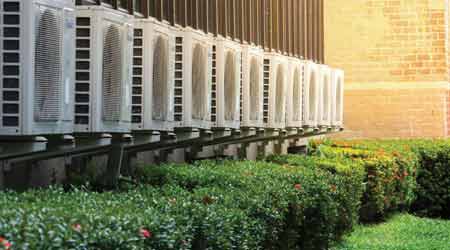What is Variable Refrigerant Flow, or VRF?
A VRF system is an advanced HVAC system that uses refrigerant as a medium for heating and cooling. VRFs use a single system that may concurrently deliver heating and cooling to various zones in a building, in contrast to traditional HVAC systems that need separate systems for heating and cooling. The primary characteristic of VRF systems is their capacity to optimize energy consumption by modifying the refrigerant flow to different indoor units according to the demand in each zone.
An Air Source Heat Pump (ASHP): What is it?
A system that uses outside air to heat or cool a building is called an air source heat pump. The system uses the heat it collects from the air to heat the interior during the colder months. It works in reverse to give cooling during the warmer months. ASHPs are frequently used in conjunction with radiators, fan coil units, or underfloor heating to effectively disperse heat or cold air throughout a structure.
Pros of VRF Systems:
· Energy Efficiency:
The exceptional energy efficiency of VRF systems is one of their biggest benefits. VRF systems reduce energy waste by continuously modifying the refrigerant flow to satisfy particular heating or cooling requirements. Compared to conventional HVAC systems, this flexibility guarantees that the system only utilizes energy when necessary, greatly lowering overall energy usage.
· Adaptability in Cooling and Heating:
In terms of multi-zone temperature regulation, VRF systems are excellent. A building’s inhabitants can benefit from increased comfort and efficiency by having the ability to individually heat or cool each zone or room according to its unique requirements. Large residences or office buildings with differing temperature requirements in different places would find this function especially helpful.
· Space-Saving Design:
VRF systems are perfect for buildings with limited space because of their small form. These systems can be deployed in more constrained places without sacrificing performance because they don’t require bulky ductwork or other equipment like boilers.
· Silent Operation:
Especially when compared to traditional heating and cooling systems, VRF systems are made to run silently. For companies, hospitals, or residential premises, a calm atmosphere is essential, and the inside units are designed to lower noise levels.
Air Source Heat Pumps’ (ASHP) Advantages:
· High Heating and Cooling Efficiency:
Excellent efficiency is a well-known attribute of air source heat pumps. By delivering up to three times as much heat energy as the electrical energy they utilize, they are significantly more efficient than conventional electric heating systems. They are a flexible option for year-round temperature management because they may also be utilized for cooling.
· Minimal Operating Expenses:
The excellent energy efficiency of ASHPs makes them economical to run. Compared to traditional electric heating systems, the system uses less electricity to run because it draws heat from the outside air. This eventually results in considerable energy bill savings, particularly in places with high electricity costs.
· Eco-Friendly:
The environmental impact of ASHPs is one of its main advantages. They are among the most environmentally beneficial HVAC options since they use airborne renewable energy. ASHPs are a great option for anyone wishing to lessen their carbon footprint because they help reduce greenhouse gas emissions by decreasing the need for fossil fuels.
· Easy Installation:
ASHPs can be installed more quickly and easily than conventional heating systems, such as ground-source heat pumps. They are perfect for structures lacking the room or capability to construct ground loops because they don’t involve the installation of underground pipes. Time and money are saved because the installation procedure is usually quicker and less disruptive.
VRF Systems and Air Source Heat Pumps: A Comparison
While both ASHPs and VRFs provide energy-efficient heating and cooling options, their intended uses are different. Larger structures with differing temperature requirements in separate zones, like shopping malls, hotels, and office buildings, are better suited for VRF systems. They may modify the refrigerant flow according to the particular requirements of each zone and concurrently cool or heat several areas.
In contrast, Air Source Heat Pumps are more adaptable in home settings and smaller business applications. They are ideal for homes, small-scale enterprises, and structures with straightforward air conditioning and heating needs. ASHPs also thrive in places with mild winters and are commonly used in conjunction with other heating systems like underfloor heating.
Final Thoughts:
Air source heat pumps and VRF systems both have unique benefits that meet various requirements. Air Source Heat Pumps are more adaptable and economical for residential and small commercial buildings, while VRF systems are best suited for large structures with a variety of temperature requirements. Building owners can benefit from considerable long-term savings, a lessened environmental impact, and increased tenant comfort by investing in these cutting-edge HVAC technologies. The future of building temperature control will surely be greatly influenced by these technologies as they develop more and become more widely available.
Frequently Asked Questions:
1. How Much Does Installing An Air Conditioner Typically Cost?
Central air conditioning systems typically cost between $3,000 and $7,000 to install, ductless mini-split systems cost between $2,000 and $5,000, and window units cost between $150 and $500. System size, location, efficiency, and other installation-related issues like labour and supplies all affect pricing.
2. Which Kind Of Air Conditioner Is Ideal For My House?
The size of your house, the ductwork that is already in place, your preferences for energy efficiency, and the environment where you live all influence the system you choose. While ductless systems perform well in homes without ductwork, central air conditioning is best suited for bigger homes with ducts. Finding the ideal solution for your needs might be aided by speaking with an HVAC specialist.


